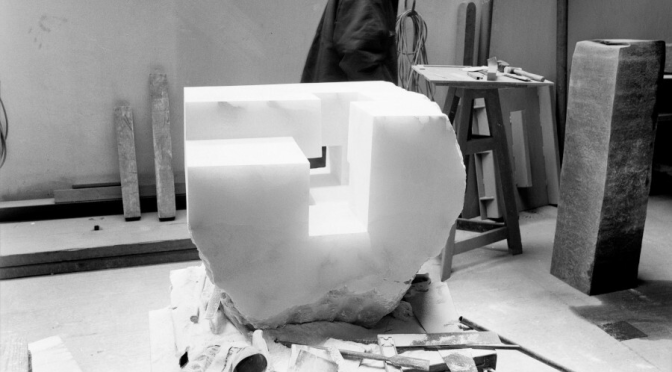One of the aspects of Basque culture that has always fascinated me is the mix of tradition with the most cutting edge ideas. Growing up in the Basque communities of the American West, I was exposed more to the traditional aspects of the culture – the dancing, the singing – and less to the avant garde that seems to define much of modern Basque culture, such as the radical rock. Basque art is no different, with some of the most important artists working in abstract spaces that, while feeling counter to the ancient traditions, are still rooted in them. Perhaps the most famous Basque sculptor, Eduardo Chillida epitomized this dichotomy.

- Eduardo Chillida Juantegui was born in Donostia on January 10, 1924. His parents were Pedro Chillida and Carmen Juantegui, who was a soprano. Chillida was a goalkeeper for Real Sociedad until a devastating knee injury ended his career, after which he studied architecture in Madrid before switching to art and studying in Paris.
- From a young age, his parents encouraged a sensitivity for art in him and his siblings. They would lock them in a room and ask them to observe the objects, to hone an awareness of everything around them, and then ask them to describe those objects after.
- It was only after returning from Paris in 1951, a bit despondent, that he both truly connected with his Basque identity and began working in iron. In Hernani, he created his first abstract sculpture, called Ilarik, that was inspired by Basque funerary steles. By 1954, he was being commissioned to create the doors to the Sanctuary of Arantzazu. In 1961, he began sculpting in wood and, in 1963, after a trip to Greece, in alabaster. Later, he also worked in concrete and clay.
- In 1975, he created the logo for the University of the Basque Country, which is still used today along with the motto Eman ta zabalzazu – give and spread – taken from Jose Mari Iparragirre‘s Gernikako Arbola. A few years later, he began work on one of his most famous pieces, the Haizeen orrazia in La Concha Bay of Donostia.
- Chillida has been highly recognized for his work across the globe. Accolades include the Grand International Prize for Sculpture at the 29th Venice Biennale in 1958, the Kandinsky Prize, the Wilhelm Lehmbruck Prize, the German Kaissering Prize, the Prince of Asturias Prize, and the Imperial Japanese Prize. In 1993, he was named a member of the American Academy of Arts and Sciences. Correspondingly, his work appears all over the world.
- In 2000, the Chillida-Leku museum opened in Hernani on the grounds of a sixteenth century baserri he and his wife purchased in the 1980s. It showcases many of Chillida’s works in a natural setting, harmonizing his art with nature. He died a couple of years later in 2002 in Donostia.
- Chillida is quoted describing his work: “My whole Work is a journey of discovery in Space. Space is the liveliest of all, the one that surrounds us. …I do not believe so much in experience. I think it is conservative. I believe in perception, which is something else. It is riskier and more progressive. There is something that still wants to progress and grow. Also, this is what I think makes you perceive, and perceiving directly acts upon the present, but with one foot firmly planted in the future. Experience, on the other hand, does the contrary: you are in the present, but with one foot in the past. In other words, I prefer the position of perception. All of my work is the progeny of the question. I am a specialist in asking questions, some without answers.”
A full list of all of Buber’s Basque Facts of the Week can be found in the Archive.
Primary sources: Zabalaga-Leku. Hernani; Elia Itzultzaile automatikoa. Chillida Juantegui, Eduardo. Auñamendi Encyclopedia. Available at: https://aunamendi.eusko-ikaskuntza.eus/en/chillida-juantegui-eduardo/ar-36023/; Eduardo Chillida, Wikipedia
Discover more from Buber's Basque Page
Subscribe to get the latest posts sent to your email.



Greetings,
Why was Chillida despondent when he left Paris? He was much appreciated in France. Monique